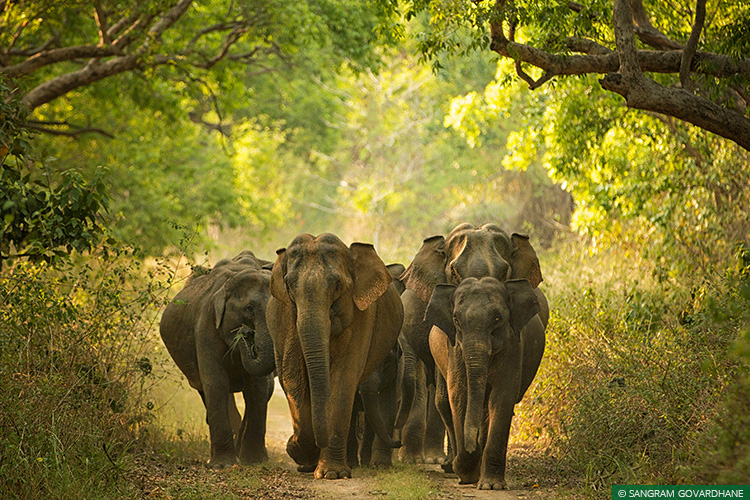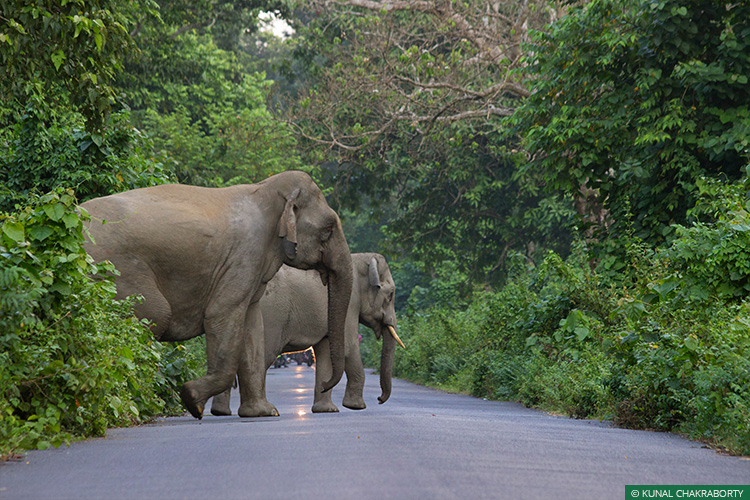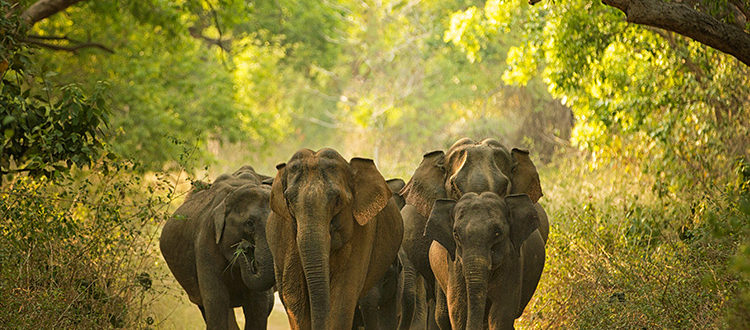The March of the Elephants
By Vivek Menon

Elephants have a way of walking that displays their incipient mood. They tramp through bamboo culms seeking tender relishes hidden amidst tangled clumps. They amble through lush grasslands, kicking a tuft every now and then, after the first monsoon rains have ensured a new carpet for them to feed on. A family group seems to saunter when at peace. A lone bull in musth, testosterone staining his face, strides up to his choice female with a rather more determined gait. Once his courtship is accepted, the two promenade languorously in between bouts of mating.
The family’s gait changes when they are about to start a long journey from one habitat to another. The stroll now picks up pace as they troop in single file. The ramble turns to a heavy definitive trudge as they shift home and hearth for the season. As the journey enters human habitation, they tiptoe, swallowing air and sniffing at unknown menacing scents. They feel their way around obstacles, like a toddler moving around the fear of new and unknown playthings.
As mobs chase the elephants, they break into a trot, a heavy lumbering run, heads bowed and bodies pressing against each other for comfort and to present a unified whole to the threat.
As the family crosses a road or a rail track there is a tentative air to the walk. The matriarch stops, then treads in slow, measured steps, watching and sensing movements and threats before venturing onto tar. The herd follows her instinctively and when the coast is clear and the matriarch has crossed, the family stumbles across in a sudden rush of frenzy. The rush lasts only till the cool earth on the other side is felt under their spongy pads. Almost instantly they slow, and if there is no threat, a little bit of comfort-feeding replaces the panic of a moment ago.
But all this changes during conflict. As mobs chase the elephants, they break into a trot, a heavy lumbering run, heads bowed and bodies pressing against each other for comfort and to present a unified whole to the threat. If the threat persists and when projectiles or burning tyres touch their bodies, the air is rent by anguished trumpets and screams. The pace quickens and every now and then an anointed member of the herd turns back in a mock charge to move the threat away. As time passes the elephants start moving in an agitated, kinetic fashion. During full-blown riots they lose even the cohesion of kith and kin as they stumble in a mad dash towards what little safety a neighbouring patch of scrub may have to offer.
A Procession of Rights
In the nation of our dreams, elephants must move as they did roughly three million years ago, when they entered the borders of a land that many millennia later would be known as India. Unfortunately, in the India of today, elephants move in a pantomime of dance and death. Sanctuary Asia’s award this year to a photographer who has captured the wretched retreat of a mother and calf set aflame by an angry mob, is an acclaim for rendering onto film the poignancy of an everyday tragedy. Something has to be done, now, for this senseless conflict to stop.
If I were an elephant, I would start to march. A steady, regular-footed, determined onwards march as of soldiers in battle. I would march to bring order to the chaos of conflict. I would march to bring a sense of normalcy to the unit that has eaten, slept and walked together till the mobs came in. I would march to bring to the attention of the other (socalled) intelligent species sharing my space, the plight of my kith and kin. I would march in protest. Inherit the language of protest from humanity and start a dharna, a hartal or a procession of rights. March to meet policy makers and the public, showcasing the utter banality of their actions towards my species. March through the very corridors that elephants have used for three millennia and that have been choked by incursive human activities. March in silent defiance, or perhaps set to a cacophony of anguished trumpets.

But, I am not an elephant. I am a fellow denizen of this country and of this Earth that I and the elephants that I love call home. I must act. For this, through the Wildlife Trust of India I am organising a Gaj Yatra. As I cannot appropriate the outrage of a species, this is not a march of defiance. It is not a march of elephants to reclaim their home, but a march to reclaim the national consciousness.
If I were an elephant, I would start to march. A steady, regular-footed, determined onwards march as of soldiers in battle.
The National Heritage Animal of India, the creature that has inspired the worship of Lord Ganesha of the Hindus and which appeared to Maya of the Shakyas predicting the greatness of the Buddha, sadly needs an image makeover. And the Gaj Yatra, run in collaboration with Project Elephant, Ministry of Environment, Forests and Climate Change, and the International Fund for Animal Welfare, is a national celebration of this magnificent and ancient Indian being. It brings art, literature, science and innovation together to highlight the plight of elephants and point to solutions that would afford them their Right of Passage. It brings Bollywood stars, children, corporate India, musicians, media magnates, sports stars, artists, conservationists and politicians together to try and celebrate the National Heritage Animal of India. And while doing this it focuses the attention of policy makers and those that can make a difference to the future of elephants. The Gaj Yatra is backed by the technical depth of the Right of Passage publication that has detailed all the 101 corridors that elephants need to move between their habitats in India.
I am unsure how long this journey will take. It has started on World Elephant Day on August 12 this year from Teen Murti Bhawan in New Delhi. It has received the blessings of Lord Ganesha the next day at the Siddhi Vinayaka Temple in Prabhadevi in a Mumbai launch. It has already called in to Bengaluru at a concert at the Vidhana Soudha, at the 100 Drums Wangala festival of the Garos, at the 20th International Children’s Film Festival at Hyderabad, and at the Ziro Festival of Music in Arunachal Pradesh. While this is happening, however, the elephant still suffers across its range.
There is no simple answer to a complex problem. I can only quote Lawrence Anthony in The Elephant Whisperer: “Perhaps the most important lesson I learned is that there are no walls between humans and the elephants except those that we put up ourselves, and that until we allow not only elephants, but all living creatures their place in the sun, we can never be whole ourselves.”
The author is Executive Director, Wildlife Trust of India and Senior Advisor to the President, IFAW. This article was first published in the December 2017 issue of Sanctuary Asia.









